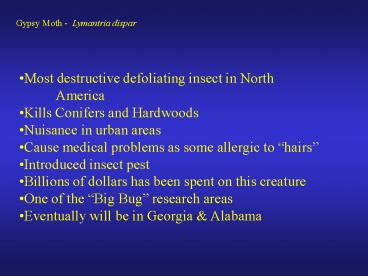Gypsy Moth - Lymantria dispar - PowerPoint PPT Presentation
1 / 32
Title:
Gypsy Moth - Lymantria dispar
Description:
... releases of sterile insects; 4) spraying with Bacillus thuringiensis (Bt), diflubenzuron (disrupts development) or the NPV virus Gypchek . – PowerPoint PPT presentation
Number of Views:164
Avg rating:3.0/5.0
Title: Gypsy Moth - Lymantria dispar
1
Gypsy Moth - Lymantria dispar
- Most destructive defoliating insect in North
America - Kills Conifers and Hardwoods
- Nuisance in urban areas
- Cause medical problems as some allergic to
hairs - Introduced insect pest
- Billions of dollars has been spent on this
creature - One of the Big Bug research areas
- Eventually will be in Georgia Alabama
2
Trouvolet and Introduction video
3
Spread
1965
1900
1995
1934
4
Mountain Side Defoliated by Gypsy moths
5
Gypsy Moth Life Cycle
6
Adult males emerge in June July and locate
females using pheromones.
Note feathery antennae of male
7
Gypsy Moth Females and Egg Masses on Tree Trunk
8
Female lay egg masses on tree trunks or other
vertical objects. An egg mass contains 100 1500
eggs which are the over-wintering stage.
9
Eggs hatch the following spring. Gypsy Moth
first instar larvae
10
Larvae emerge in Mid-April and disperse by
ballooning Have very long hairs are easily
airborne
11
Instars 4-6 feed on new foliage first and then
move on to older foliage if necessary
12
Mature Gypsy Moth larvae are large insects and
one can eat several leaves a day.
13
Gypsy Moths often pupate on tree trunks. Pupae
are found in June and July which lasts about 2
weeks. Pupal case
14
- Adults emerge,
- find each other and
- the cycle continues.
- One generation
- per year.
- Females do not FLY.
15
Gypsy Moth Ecology
16
Management Considerations
Natural enemies Parastoids Pathogens Predat
ors Climate
17
Ant attacking Gypsy Moth Pupa
18
White footed mice eating Gypsy Moths
19
Diptera Parasitoid on egg masses
20
Gypsy Moth Video
21
Management Considerations
22
(No Transcript)
23
Alabama Gypsy Moth Survey Program Part of USDA
Forest Services Slow the Spread
Program Cooperative effort between USDA/APHIS,
Auburn University Alabama Extension Service
24
- Gypsy Moth Slow the Spread Program
- Expectations
- 1)
- 2)
- 3)
25
- Slow the Spread has three main thrusts
- TrappingOfficials monitor gypsy moth populations
by placing a grid of pheromone-baited traps to
allow early detection in of the moth in new
areas. - Suppression Reduce populations using various
options including 1) mating disruption with
pheromone flakes, 2) mass trapping 3) releases
of sterile insects 4) spraying with Bacillus
thuringiensis (Bt), diflubenzuron (disrupts
development) or the NPV virus Gypchek. - Regulatory Work Human movement of infested
articles is a major factor in spread. Regulatory
actions to reduce such movement will be enforced.
26
Pheromone Trap and dispensers
27
- Gypsy Moth captures 2000
- Jefferson
- Winston
- Morgan
28
- Gypsy Moth captures 2001
- Cleburne
- Barbour
- Butler
29
- Gypsy Moth
- captures 2002
- Limestone
- Winston
- Greene
- Dallas
- Tuscaloosa
30
- Gypsy Moth captures 2003
- Lauderdale
31
- Gypsy Moth captures 2004
- Madison
- Blount
- Calhoun
32
End of Gypsy Moth Section






























